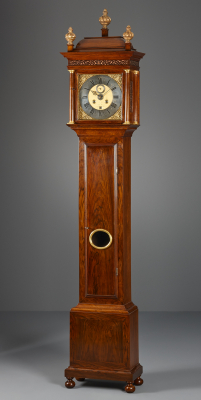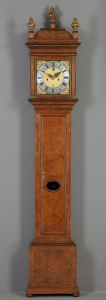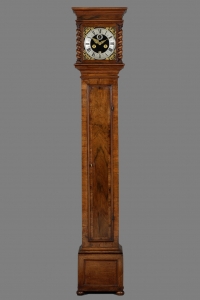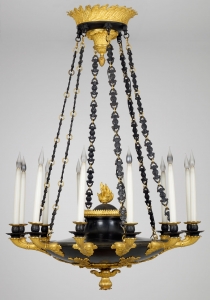Dutch longcase clock, Fromanteel & Clarke
Dutch longcase clock, Fromanteel & Clarke
Movement
The one-month movement has a going train with an anchor escapement. The plates are interconnected by five pillars. The rack striking train fully strikes the hours on the large bell and strikes half hours on the small bell.
Dial
The dial with gilt centre and silvered engraved ring displays the hours in Roman numerals and the minutes in Arabic numerals. The numeral ring is flanked at the corners by gilt bronze openwork. Below the numeral XII is a seconds bit, below which, in the centre, is an alarm disc. Above the numeral VI is a date mark. The signature is engraved between the numerals V and VII: Fromanteel & Clarke.
Case
The oak cabinet is fully veneered with walnut veneer and rests upon four flattened ball feet surmounted by a concave plinth carrying the straight base section. Above this is the trunk, with a centrally placed oval lenticle. The dial is flanked by columns, creating the impression that the frieze is borne by the columns alone. The frieze is crowned with a bonnet with three gilt turned wooden ball finials.
Ahasuerus Fromanteel (1607-1693) was the first of a family of English/Dutch clockmakers who settled in London in 1625. His marriage to Maria de Bruijne in 1631 produced three sons, all of whom became renowned clockmakers, establishing a business on Vijgendam in Amsterdam in 1680. With businesses in London, Amsterdam and Newcastle, the Fromanteel family was the world’s first international clockmaking business. In the 1680s, the three brothers Fromanteel – Johannes, Ahasuerus II and Abraham – decided to use a single shared signature, namely Fromanteel, without any initials or place of business.
In 1694, Christopher Clarke (1668-ca. 1730) married Ahasuerus II’s only daughter, Anna. From 1696 on, Ahasuerus II associated with his son-in-law Christopher Clarke under the name Fromanteel & Clarke. After Ahasuerus II’s death, Clarke entered into a partnership with the last remaining Fromanteel, Abraham, in 1703. They used the signature Fromanteel & Clarke, not noting the place of business. Clocks continued to be produced under the Fromanteel name until 1722.
Literature:
Enrico Morpurgo, Nederlandse klokkenmakers en horlogemakers vanaf 1300, 1970, p. 44
- Period
- ca. 1710
- Material
- oakwood case with walnut veneer, gilt bronze, silvered dial
- Signature
- Fromanteel & Clarke
- Dimensions
- 245 x 50 x 27.5 cm
- Diameter
- 42.50 cm
Global shipping available







